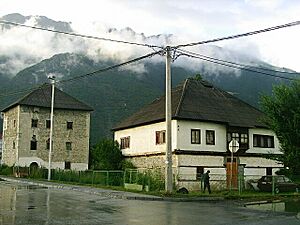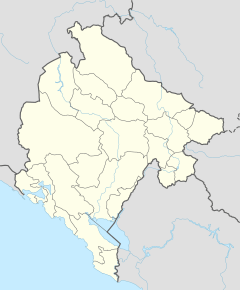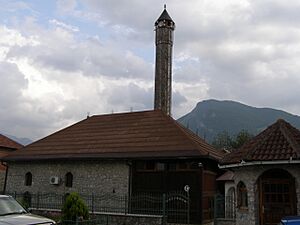Gusinje facts for kids
Quick facts for kids
Gusinje
Гусиње
Gucia |
|||
|---|---|---|---|
|
Town and municipality
|
|||

Typical households in Gusinje
|
|||
|
|||
| Country | |||
| Region | Northern Montenegro | ||
| Municipality | |||
| Area | |||
| • Total | 3.73 km2 (1.44 sq mi) | ||
| Elevation | 1,014 m (3,327 ft) | ||
| Population
(2011)
|
|||
| • Total | 1,673 | ||
| Time zone | UTC+1 (CET) | ||
| • Summer (DST) | UTC+2 (CEST) | ||
| Vehicle registration | GS | ||
| Climate | Cfb | ||
Gusinje (Cyrillic: Гусиње, pronounced [ɡǔsiɲe]; Albanian: Gucia) is a small town in Montenegro. It is located in the northern part of the country. In 2011, about 1,673 people lived there. Gusinje is also the main town of the Gusinje Municipality.
Contents
What's in a Name?
The name Gusinje might come from two different ideas. One idea is that it comes from the Slavic word guska, which means "goose". Another idea is that it comes from an old Illyrian word, Geusiae. This is also where the Albanian name for the town, Gucia, might come from.
In old records, the town's name was written in different ways. Some examples are Gousino, Gustigne, Gusna, and Gusinye.
Geography and Nature
Gusinje is in a beautiful mountain area called the Accursed Mountains. It sits at an elevation of 1,014 meters (about 3,327 feet). The highest mountain in Montenegro, Zla Kolata, is only about 10 kilometers (6 miles) south of Gusinje. This mountain is part of the amazing Prokletije National Park.
The town is located on the Vermosh River. This river flows east towards Plav. About 2 kilometers (1.2 miles) south of Gusinje, you can find the famous Ali Pasha's springs. These springs are called Alipašini izvori or Krojet e Ali Pashës. The water from these springs forms Vruja creek, which joins the Vermosh River. The Vermosh River eventually flows into Lake Plav.
Gusinje is the center of its own municipality. For many years, from 1953 to 2014, it was part of the Plav Municipality. But in 2014, it became a separate municipality again. The town itself covers about 3.73 square kilometers (1.44 square miles). The whole municipality is much larger, about 157 square kilometers (61 square miles). Much of this land is mountainous and was once used for raising animals.
A Look at History
Gusinje has a long and interesting history. It was first mentioned in the 14th century as a stop for traders. These traders traveled on routes connecting different cities like Ragusa and Peć.
In 1485, records show Gusinje was a village with 96 households. This was quite a large settlement for that time.
The Ottoman Era
Gusinje was an important trading spot during the time of the Ottoman Empire. It connected northern Albania, Montenegro, and Kosovo. Because of this trade, the town became wealthy. However, it also became a target for local tribes who were against Ottoman rule.
To protect the trade routes, a fortress was built near Gusinje around 1612. This fortress was meant to stop attacks from tribes like the Kelmendi. In 1614, the village had about 100 households and a group of 237 soldiers.
Over time, many people from different tribes settled in Gusinje. These tribes included Kelmendi, Kuči, and Shala. Many of their descendants, who were originally Christian, later became Muslim. This often happened to gain more rights and privileges. Different mosques in Gusinje were built by these different family groups. For example, the Cekaj mosque was built in 1687 by the Cekaj family. The New Mosque, built in 1899, is known as Radončića after the Radončići family.
In 1765, the Vezir's mosque was built in the town center by Kara Mahmud Bushati. This shows the influence of the Pashalik of Shkodra, a powerful local ruler.
Battles and Changes
As the Ottoman Empire became weaker in the 1800s, Gusinje and Plav were planned to become part of the independent Principality of Montenegro. However, the people of Gusinje did not agree with this. They formed the League of Prizren to resist.
A famous leader from Gusinje, Ali Pasha Shabanagaj, led the League of Prizren. In the Battle of Novšiće, his forces defeated the Montenegrin army. This battle was very important for the Albanian National Awakening. It showed that people were willing to fight for their land. Even though the battle was near Novšiće, it became known as the Gusinye Incident because of Gusinje's key role.
In 1893, Gusinje was a busy town with 1,600 households, 5 mosques, and 240 shops.
20th Century and Today
In 1912, the Montenegrin army took control of the region. This led to a difficult time for the local people. Many were killed, and some were forced to change their religion. These events are still talked about today in Montenegro. In 2013, the President of Montenegro, Filip Vujanović, even said that "the crimes performed in Plav and Gusinje are the dark side of the Montenegrin history."
After World War I, Gusinje became part of the new Kingdom of Serbs, Croats and Slovenes (later Yugoslavia). In 1919, there was a revolt in the area against this. Many Albanians from Gusinje and Plav moved to Albania during these times.
During World War II, Gusinje was briefly part of Albania. After the war, the borders from 1913 were put back in place. Gusinje lost its status as a separate municipality in 1953, which caused many people to move away. But in 2014, Gusinje proudly became a municipality again.
Language and Culture
Most people in Gusinje are Muslim. They speak either Albanian or a Slavic language. The Slavic language spoken in Gusinje and Plav has been greatly influenced by Albanian. This is because many Slavic speakers in Gusinje originally spoke Albanian and later switched languages.
Important Buildings
Gusinje has several old and beautiful mosques. The oldest one still standing is the Čekića džamija (or xhamia e Cekajve). It was built by the Cekaj family. The second oldest is the Vezir's mosque (vezirova džamija/xhamia e vezirit), built in 1765. The New Mosque (nova džamija/xhamia e re), also called Radončića, was built in 1899. There are also ruins of other old mosques, like the one built during the reign of Sultan Ahmed I.
People of Gusinje
Since 1913, many people have moved away from Gusinje. This has caused the town's population to shrink. However, many people around the world still have family roots in Gusinje. The municipality reports that about 18,400 people who live outside the area trace their origins to Gusinje. Most of them live in the United States.
Population Over Time
|
|
|||||||||||||||||||||||||||||||||||||||||||||||||||||||||
Religions in Gusinje
| Religion (2011 Census) | Number | |
|---|---|---|
| Percentage | ||
| Eastern Orthodoxy | 67 | 4.00% |
| Islam | 1,580 | 94.44% |
| Catholicism | 18 | 1.08% |
| Christians | 0 | 0% |
| Protestants | 0 | 0% |
| Jehovah Witness | 0 | 0% |
| Buddhist | 0 | 0% |
| Adventist | 0 | 0% |
| Agnosticism | 0 | 0% |
| Atheism | 0 | 0% |
| Undeclared | 0 | 0% |
| Other | 8 | 0.5% |
Sports in Gusinje
Gusinje has its own football (soccer) team called FK Gusinje. They play in the country's third-highest league. Their home games are played at the City Stadium. The town also has a basketball team named KK Stršljen.
Famous People from Gusinje
- Ismail Nikočević, a former mayor of Gusinje
- Ali Paša Gusinjski, an Albanian military leader
- Redžo Mulić, an Albanian composer
- Dženan Radončić, a Montenegrin football player
- Fahrudin Radončić, a businessman and politician
- Dino Radončić, a basketball player
Sister Cities
Gusinje is connected with another city as a "sister city":
Images for kids
See also
 In Spanish: Gusinje para niños
In Spanish: Gusinje para niños







